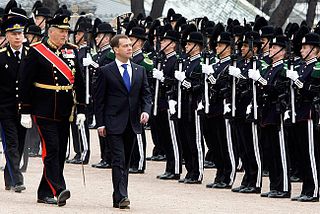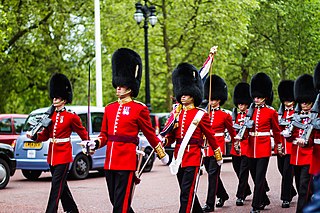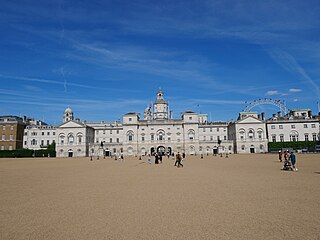Related Research Articles

Buckingham Palace is a royal residence in London, and the administrative headquarters of the monarch of the United Kingdom. Located in the City of Westminster, the palace is often at the centre of state occasions and royal hospitality. It has been a focal point for the British people at times of national rejoicing and mourning.

The Royal Regiment of Horse Guards, also known as the Blues, or abbreviated as RHG, was one of the Cavalry regiments of the British Army, and part of the Household Cavalry. In 1969, it was amalgamated with the 1st The Royal Dragoons to form the Blues and Royals.

In some militaries, foot guards are senior infantry regiments. Foot guards are commonly responsible for guarding royal families or other state leaders, and they also often perform ceremonial duties accordingly, but at the same time are combat soldiers.
The Household Cavalry (HCAV) is a corps of the Household Division, made up of the two most senior regiments of the British Army; The Life Guards and The Blues and Royals. They have taken part in every major conflict since 1660. These regiments are divided between the Household Cavalry Regiment stationed at Wing Barracks in Wiltshire, with an armored reconnaissance role, and the ceremonial mounted unit, the Household Cavalry Mounted Regiment, garrisoned at Hyde Park Barracks in London. Both the HCMR and HCR are made up of elements of the Life Guards and the Blues and Royals. The Household Cavalry is part of the Household Division and is the King's official bodyguard. Although the Household Cavalry Regiment is armoured, it is not part of the Royal Armoured Corps, being assigned to the Household Division.

The King's Guard are sentry postings at Buckingham Palace and St James's Palace, organised by the British Army's Household Division. The Household Division also mounts sentry postings at Horse Guards, known as the King's Life Guard.

Horse Guards is a historic building in the City of Westminster, London, between Whitehall and Horse Guards Parade. It was built in the mid-18th century, replacing an earlier building, as a barracks and stables for the Household Cavalry. The current and previous buildings were, between the early 18th century and 1858, the main military headquarters for the British Empire. Horse Guards originally formed the entrance to the Palace of Whitehall and later St James's Palace; for that reason it is still ceremonially defended by the King's Life Guard.
An office created in the Private Secretary's Office of the Royal Household of the Sovereign of the United Kingdom in 2004 after a Daily Mirror reporter used a false CV to obtain a job at Buckingham Palace. A subsequent government report recommended the establishment of the Director of Security Liaison role. The first office-holder was Brigadier Jeffrey Cook, a former Special Air Service (SAS) officer. He served until 2008. John Lynes CVO, another military officer, was the Director from around 2015 to 2023.

Public duties are performed by military personnel, and usually have a ceremonial or historic significance rather than an overtly operational role.

Victoria Barracks is a British Army barracks located 0.25 miles (0.40 km) south of Windsor Castle.

Combermere Barracks, Windsor is a British Army installation 0.9 miles (1.4 km) from Windsor Castle.

Cavalry Barracks is a former British Army installation located north of Hounslow Heath in Hounslow, west London. Hounslow was one of 40 new barracks established around the country in the wake of the French Revolution, to guard against the dual threats of foreign invasion and domestic sedition. The barracks later became a busy depot for the London military district. The barracks have been described by Historic England as 'one of the most significant and complete barracks in the country'; as of June 2021 the site is scheduled to be developed as a sustainable living project by Hounslow Council.

London District (LONDIST) is the name given by the British Army to the area of operations encompassing the Greater London area. It was established in 1870 as Home District.
The Household Cavalry Mounted Regiment (HCMR) is a cavalry regiment of the British Army tasked primarily with ceremonial duties. Part of the Household Division, it is classed as a regiment of guards, and carries out mounted ceremonial duties on State and Royal occasions. The HCMR is one of two operational units that form the Household Cavalry (HCav), the other being the Household Cavalry Regiment (HCR), a formation reconnaissance regiment, with front-line combat duties.

The 1st Armoured Infantry Brigade was an infantry brigade of the British Army with a long history including service during both the First and the Second World Wars. It was based at Tidworth Camp. Previously, it has been designated 1st (Guards) Brigade, 1st Infantry Brigade, 1st Mechanised Brigade, and under the initial Army 2020 reforms assumed the title of 1st Armoured Infantry Brigade. Under the Future Soldier programme, the brigade merged with the 1st Artillery Brigade to form the 1st Deep Recce Strike Brigade Combat Team.

Windsor Castle is a royal residence at Windsor in the English county of Berkshire. It is strongly associated with the English and succeeding British royal family, and embodies almost a millennium of architectural history.
The Household Cavalry Composite Regiment was a temporary, wartime-only, cavalry regiment of the British Army consisting of personnel drawn from the 1st Life Guards, 2nd Life Guards and Royal Horse Guards. It was active in 1882 for service in the Anglo-Egyptian War, in 1889–1900 during the Second Boer War, from August to November, 1914 during the opening months of World War I and in World War II.

The regimental depot of a regiment is its home base for recruiting and training. It is also where soldiers and officers awaiting discharge or postings are based and where injured soldiers return to full fitness after discharge from hospital before returning to full duty. Normally, a variety of regimental stores will also be kept at the depot. The regimental depot is not the same as the regimental headquarters, though in practice the two will often be co-located in the same place.

The Windsor Castle Act 1848 was an Act of Parliament enacted for the British royal family that reformed land use and rights around Windsor Castle, in Berkshire. The Act's main purpose was to create Home Park. All new roads and bridges were built by 1850. The result turned the former royal estate, which was known as Little Park, into the royal private estate of Home Park.

The page contains the current structure of the British Army. The British Army is currently being reorganised to the Future Soldier structure.
Future Soldier is a reform of the British Army resulting from the Integrated Review of Security, Defence, Development and Foreign Policy published in March 2021. The aim of the reform is to create a more lethal, agile and expeditionary force, able to fight and win wars and to operate in the grey-zone between peace and war. Future Soldier was published on 25 November 2021 and deals with the organizational changes of the British Army, with changes to personnel and equipment were set out in the Defence in a Competitive Age paper published on 22 March 2021.
References
Citations
- ↑ South, p.35.
- ↑ Rowse, pp.52-3, p.61.
- ↑ Tite, p.110; Robinson, p.60.
- ↑ Robinson, p.59.
- ↑ Robinson, p.57.
- ↑ Tighe and Davis, p.655.
- ↑ Tighe and Davis, p.656.
- ↑ "Home Office Circular 018 / 2007 (Trespass on protected sites - sections 128-131 of the Serious Organised Crime and Police Act 2005)". GOV.UK. Home Office. 22 May 2007. Retrieved 8 August 2017.
Bibliography
- Robinson, John Martin. (2010) Windsor Castle: the Official Illustrated History. London: Royal Collection Publications. ISBN 978-1-902163-21-5.
- Rowse, A. L. (1974) Windsor Castle in the History of the Nation. London: Book Club Associates. ISBN 978-1-902163-21-5.
- South, Raymond. (1977) The Book of Windsor. Chesham, UK: Barracuda Books. ISBN 0-86023-038-4.
- Tighe, Robert Richard and James Edward Davis. (1858) Annals of Windsor, being a history of the castle and town, with some account of Eton and places adjacent, volume II. London: Longman.
- Tite, Catherine. (2010) Portraiture, Dynasty and Power: Art Patronage in Hanoverian Britain, 1714-1759. Amherst, US: Cambria Press. ISBN 978-1-60497-678-6.